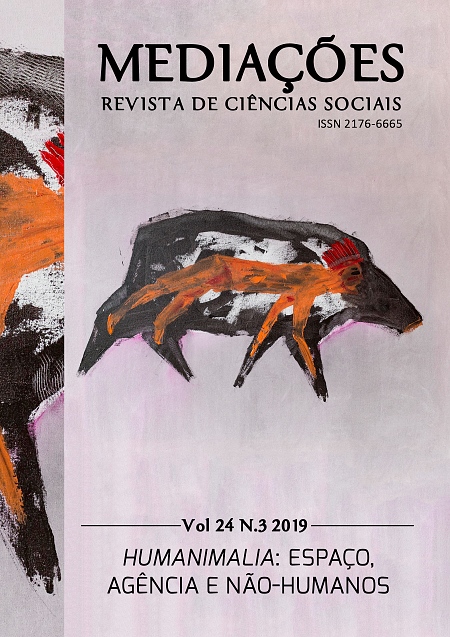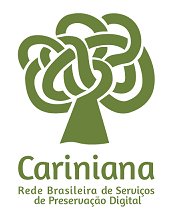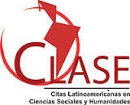Cultive of queixadas, peixes-mandioca and corujinhas boideiras: the relationships between human beings, animals and maestry in indigenous land of guaporé river (Rondônia)
DOI:
https://doi.org/10.5433/2176-6665.2019v24n3p28Keywords:
Indigenous ethnology., Rondônia, Human-animals relations, Classification, Nature and CultureAbstract
The indigenous land of Guaporé river, located in the southwestern of Amazon, in the state of Rondônia, constitute a multi-ethnic space and linguistic were ten indigenous community lives. Within the regional context, from the perspective of the Kujubim, group belonging to the Txapakura language family, to reflect and reveal some relationships existing between humans, animals, owner-spirits and underwater villages. In advance, it is possible to affirm that such relationships cannot be thought out of the context in which they are designed, that is, of the spaces in which they are establish, such as the village, the river, the forest and the dreams. Through diverse negotiations of these spaces and the perspectives of human beings and nonhumans habit them, the places, beings and things end up being classified according to different statutes depend on the types of relationships that are established by each other. It is in this point and context, therefore, I start from the following questions: how can the white-lipped pecary be, at the same time, animal for humans and “cultivate” for your owners? How can the fishes, which are animals for humans, can be farm products for the people of an underwater village? This is also true of the corujinhas-da-noite (little owls) that are animals, but owners and tapir comadres.Downloads
References
ANDRELLO, G.; GUERREIRO, A.; HUGH-JONES, S. Space-time transformations in the upper Xingu and upper Rio Negro. Sociologia e Antropologia, Rio de janeiro, v. 5, n. 3, p. 699-724, 2015.
BERLIN, B. Ethnobiological classification: principles of categorization of plants and animals in traditional societies. Princeton University Press, 1992.
BEVILAQUA, C.; VELDEN, F. V. (org.). Parentes, vitimas, sujeitos: perspectivas antropológicas sobre a relação entre humanos e animais. São Carlos: EDUSFCar/ Curitiba: EDUFPR, 2016.
CASTRO, E. V. Os pronomes cosmológicos e o perspectivismo ameríndio. Mana, Rio de Janeiro, v. 2, n. 2, p. 115-144, 1996.
CASTRO, E. V. Perspectival anthropology and the metod of controled equivocation. Tipití, [S.l.], v. 2, n. 1, p. 3-22, 2004.
DESCOLA, P. Beyond nature and culture. Proceedings of the British Academy, London, v. 139, p. 137-155, 2006.
DESCOLA, P. Estrutura ou sentimento: a relação com o animal na Amazônia. Mana: Estudos de Antropologia Social, Rio de Janeiro, v. 4, n. 1, 1998.
DESCOLA, P. La selva culta: simbolismo y praxis en la ecología de los Achuar. Quito: Ed. Abya Yala. 1986.
DESCOLA, P. Societies of Nature and Nature of Society. In: KUPER, A. (ed.). Conceptualizing society. London: Routledge, 1992.
DURAN, I. R. Descrição fonética e lexical do dialeto <Kaw Tayo> (Kujubim) da língua Moré. 2000. Dissertação (Mestrado em Linguística) - Universidade Federal de Rondônia, Porto Velho, 2000.
FAUSTO, C. Donos demais: maestria e domínio na amazônia. Mana, Rio de janeiro, v. 14, n. 2, p. 329-366, 2008.
GALLOIS, D. T. (org.). Redes de relações nas Guianas. São Paulo: Associação Editorial Humanitas: Fapesp. 2005. 328p. (Série Redes Ameríndias NHII-USP).
GARCIA, U. Macacos também choram, ou o esboço para um conceito ameríndio de espécie. Revista do Instituto de Estudos Brasileiros, São Paulo, n. 69, 2018.
JARA, F. El camino del Kumu: ecología y ritual entre los Akuriyó de Surinam. Quito: Biblioteca Abya-Yala, 1996.
LÉVI-STRAUSS, C. O pensamento selvagem. Rio de Janeiro, 8. Ed. Papirus: 2005.
LIMA, T. S. O dois e seu múltiplo: reflexões sobre o perspectivismo em uma cosmologia Tupi. Mana, Rio de Janeiro, v. 2, n. 2, 1996.
LIMA, T. S. O que é um corpo? Religião e Sociedade, Rio de Janeiro, v. 22, n. 1, p. 9-19, 2002.
MALDI, D. O Complexo cultural do marico: sociedades indígenas dos rios Branco, Colorado e Mequens, afluentes do médio Guaporé. Boletim do Museu Paraense Emílio Goeldi, série Antropologia, Belém, v. 7, n. 2, p. 209-269, 1991.
MELLO, M. Animal and society: an introduction to human/animal studies. New York: Columbia University Press, 2012.
OLIVEIRA, J. C. Classificação em cena: algumas formas de classificação das plantas cultivadas pelos Wajãpi do Amapari (AP). 2006. Dissertação (Mestrado em Antropologia) - Universidade de São Paulo, São Paulo, 2006.
OVERING, J. O mito como história: um problema de tempo, realidade e outras questões. Mana, Rio de Janeiro, v. 1, n. 1, 1995.
PINTO, N. S. Do poder do sangue e da chicha: os Wajuru do Guaporé (Rondônia). Dissertação de mestrado, Antropologia, Paraná, 2009.
PINTO, N. S. Entre as teias do Marico: parentes e pajés djeoromitxi. 2014. Tese (Doutorado em Antropologia Social) - Universidade de Brasília, Brasília, 2014.
RIVIÈRE, P. AAE na Amazônia. Revista de Antropologia, São Paulo, v. 38, n. 1, 1995.
VELDEN, F. V. Apresentação ao dossiê: animalidades Plurais. Rau – Revista de Antropologia da UFSCar, Florianópolis, v. 7, n. 1, 2015.
VELDEN, F. V. Inquietas companhias: sobre os animais de criação entre os Karitiana. São Paulo: Alameda, 2012.
VELDEN, F. V.; CEBOLLA BADIE, M. A relação entre natureza e cultura em sua diversidade: percepções, classificações e práticas. Avá. Revista de Antropología, Misiones, n. 19, p. 15-47, 2011.
Downloads
Published
How to Cite
Issue
Section
License
Copyright (c) 2019 Gabriel Sanchez

This work is licensed under a Creative Commons Attribution 4.0 International License.
Copyright on articles published in Mediações belongs to the author(s): in the case of partial or entire republication of the original publication, we ask author(s) to indicate the original publication in the periodical.
Mediações uses the Creative Commons Attribution 4.0 International license, which allows Open Access, enabling any user to read, download, copy and disseminate its content so long as adequately referenced.
The opinions expressed by the author(s) are their sole responsibility.
Funding data
-
Fundação de Amparo à Pesquisa do Estado de São Paulo
Grant numbers 14793-3/2017
































